
Floor sanding is more than just a cosmetic enhancement; it’s a precise process that involves science and craftsmanship to restore the beauty and integrity of wooden floors. Understanding the science behind floor sanding can help homeowners in London appreciate the complexity and importance of this task. Here’s an in-depth look at the science behind floor sanding and the steps involved in achieving flawless results.
- The Basics of Wood Structure

Wood Anatomy:
- Cellular Structure: Wood is composed of cells and fibers that give it strength and flexibility. The sanding process smooths out the surface by removing the damaged outer layer.
- Grain Patterns: The unique grain patterns in wood are formed by the growth rings of the tree. Sanding enhances these patterns, bringing out the natural beauty of the wood.
Types of Wood:
- Hardwoods vs. Softwoods: Hardwoods like oak and maple have denser structures, making them more durable and suitable for flooring. Softwoods like pine are less dense and may require more careful sanding.
- The Sanding Process Explained
Step-by-Step Breakdown:
- Initial Inspection:
- Assessing the Floor: Before sanding, the floor is inspected for damage, such as deep scratches, dents, and loose boards. This helps in planning the sanding approach and identifying any necessary repairs.
- Preparation:
- Cleaning and Clearing: The room is cleared of furniture, and the floor is thoroughly cleaned to remove dirt and debris. Nails and staples are removed or hammered down to avoid damaging the sanding equipment.
- Coarse Sanding:
- Removing Old Finish: The first sanding pass uses coarse-grit sandpaper (40-60 grit) to remove the old finish and level the surface. This step reveals the raw wood underneath.
- Using the Drum Sander: A drum sander is typically used for this step, as it can efficiently remove large amounts of material.
- Medium Sanding:
- Smoothing the Surface: The second pass uses medium-grit sandpaper (80 grit) to smooth out the roughness left by the coarse sanding. This step prepares the floor for the final sanding.
- Edge Sanding: An edge sander is used to sand the areas near walls and corners that the drum sander cannot reach.
- Fine Sanding:
- Final Smoothing: The final sanding pass uses fine-grit sandpaper (120 grit) to achieve a smooth, even surface. This step ensures the floor is ready for finishing.
- Orbital Sander: An orbital sander may be used for the final pass to create a uniform finish.
- Dust Removal:
- Thorough Cleaning: After sanding, the floor is vacuumed and wiped with a tack cloth to remove all dust and debris. Dust management is crucial to ensure a smooth finish.
- Finishing:
- Applying the Finish: The chosen finish (water-based, oil-based, or wax) is applied in multiple thin coats. Each coat is allowed to dry thoroughly before applying the next.
- Buffing Between Coats: Light sanding or buffing between coats helps achieve a smooth, durable finish.
- Scientific Principles at Work
Abrasive Technology:
- Sandpaper Grits: The grit of sandpaper refers to the size of the abrasive particles. Coarse grits remove material quickly, while fine grits produce a smooth finish.
- Abrasive Materials: Common abrasive materials include aluminum oxide and silicon carbide, known for their durability and effectiveness.
Friction and Heat:
- Heat Generation: Sanding generates friction, which produces heat. Managing heat is crucial to avoid burning the wood or damaging the sandpaper.
- Controlled Pressure: Applying even pressure ensures consistent sanding and prevents gouging or uneven surfaces.
Dust Extraction:
- Health and Safety: Sanding produces fine dust particles that can be harmful if inhaled. Modern sanders with dust extraction systems help protect health and improve the working environment.
- Environmental Considerations: Proper dust management also prevents contamination of the surrounding areas, maintaining a clean workspace.
- Importance of Professional Expertise

Skilled Craftsmanship:
- Experience and Technique: Professional floor sanders have the experience and skills to manage the nuances of different wood types and conditions.
- Precision and Consistency: Achieving a flawless finish requires precision and consistency, which professionals are trained to deliver.
Quality Equipment:
- Advanced Machinery: Professionals use high-quality sanding machines and dust extraction systems that are more efficient and effective than DIY options.
- Expert Maintenance: Regular maintenance of equipment ensures optimal performance and results.
Conclusion
Understanding the science behind floor sanding highlights the importance of precision, technique, and the right tools in achieving beautiful, long-lasting results. For London homeowners, appreciating the complexity of the process can enhance their appreciation for professional services and the transformative impact of well-sanded floors. Whether undertaking a DIY project or hiring experts, knowing the intricacies of floor sanding ensures informed decisions and exceptional outcomes. Embrace the science and craftsmanship of floor sanding to enjoy the timeless beauty and durability of your wooden floors.









How to Handle Floor Stains from Pets
How to Handle Floor Stains from Pets Pets bring joy and companionship to our homes,[Read more...]
The Benefits of Floor Sanding for Open House Showings
London Property Tips Home About Contact The Benefits of Floor Sanding for Open House[Read more...]
How to Extend the Life of Your Sanded Floors
Sanded floors can dramatically enhance the aesthetic appeal and value of your home. To ensure[Read more...]
Gallery 04 – Engineering wooden floor
[Read more...]
Sep
How to Achieve a Smooth Finish on Your Sanded Floors
How to Achieve a Smooth Finish on Your Sanded Floors Expert Tips for Professional-Quality[Read more...]
Ultimate Guide to Floor Sanding in London: Everything You Need to Know
Introduction Welcome to Alchemist Floor Sanding, London’s leading floor sanding experts. If you’re considering revamping[Read more...]
Floor sanding and renovation and installation services in Hertfordshire
Hertfordshire: A County of Scenic Beauty and Modern Living Hertfordshire is a picturesque county in[Read more...]
Why Floor Sanding is Essential for London Homes
Introduction Floor sanding is a crucial maintenance task for homeowners in London. It goes beyond[Read more...]
Engineered Wood Flooring
Choosing the finishes for your house can be the most exciting part. Wood flooring adds[Read more...]
Sep
How to Choose the Right Color Stain for Your Sanded Floors
How to Choose the Right Color Stain for Your Sanded Floors Enhance the Beauty[Read more...]